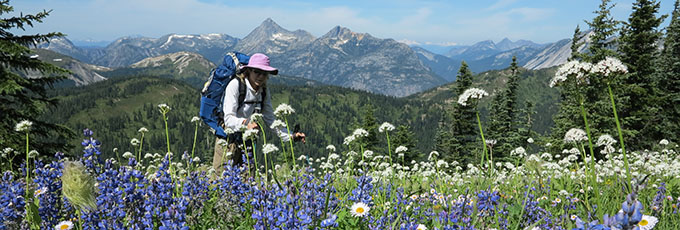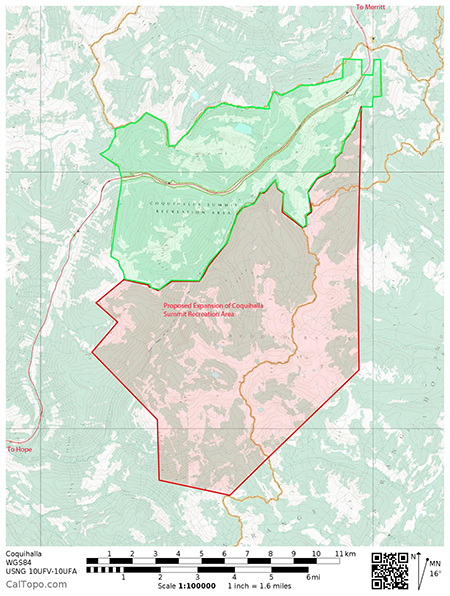

Write a Letter
Write a letter telling the government you support the proposal to expand the Coquihalla Summit Recreation Area.
WRITE TO:
The Premier premier@gov.bc.ca
Hon. George Heyman, Minister of the Environment and Climate Change Strategy ENV.minister@gov.bc.ca
Hon. Doug Donaldson, Minister of Forests, Lands, Natural Resource Operations and Rural Development FLNR.Minister@gov.bc.ca
Expand the Coquihalla Summit Recreation Area
There is a small pocket of stunning wilderness in the Coquihalla area that deserves to be protected. It is immediately south of the Coquihalla Recreation Area and would be a perfect candidate for an expansion of the park. The terrain is quite different than the existing recreation area and offers outstanding alpine hiking with more expansive meadows and scenic ridge walking.
Proposal
This information page describes a proposal to expand the Coquihalla Summit Recreation Area to include the adjoining area to the south surrounding Coquihalla Mountain.
The proposed expansion would include the mountains in the Bedded Range on the south and east side of the Coquihalla River from Coquihalla Mountain north to Britton Ridge (see map below). The unique undeveloped natural features, the outstanding visual resources and the stunning recreational opportunities of the proposed expansion would significantly strengthen the objectives of the recreation area and would be an important addition to the protected areas of southwestern BC.
Gallery
-
Map of Proposed Expansion

Download KML of boundary of proposed expansion
Background
Canada has committed under the United Nations Convention on Biological Diversity to increase its protected areas to 17% from the current 10.6% by 2020. That's a 60% increase! The proposed expansion is a prime candidate to help meet this increase.
The Coquihalla Summit Recreation Area was established in 1986 in order to conserve the Coast-Cascade Dry Belt Landscape and to protect significant destination recreational opportunities such as hiking, rock climbing and backcountry skiing. The Recreation Area also serves the needs of the travelling public by protecting an attractive mountain environment for scenic driving and by providing convenient roadside recreational opportunities. More information on the existing Coquihalla Summit Recreation Area is available on the BC Parks webpage.
Conservation
The expansion of the recreation area would strengthen its conservation objectives by protecting the unlogged valleys of Baldwin, Hidden and Carry Creeks together with the adjoining spectacular alpine areas. The old growth forest of these valleys is not suitable for logging because of the difficulties of building access roads through the steep unstable terrain. They present a rare opportunity to increase old growth and wilderness protection in southwestern BC. Furthermore protection of the unlogged valleys of Baldwin and Hidden Creeks will retain the outstanding scenic qualities of the Coquihalla Highway corridor.
Landscape diversity of the Coquihalla Summit Recreation Area would be significantly increased. Coquihalla Mountain is an extinct volcano and the volcanic rocks of the Bedded Range contrast sharply with the primarily igneous rocks of Zopkios Ridge and the existing recreation area. As a result the geography of the proposed expansion is significantly different and provides a unique addition to the recreation area. The ridges and peaks of the Bedded range are characterized by rounded summits with gentle alpine slopes and extensive meadows. This is in sharp contrast to the steep narrow granitic domes and ridges of the existing Coquihalla Summit Recreation Area.
The proposed expansion would roughly double the size of the protected area from approximately 60 sq. km to 160 sq. km. This is especially important for wildlife where size is critical for more extensive travel corridors and habitat connectivity. The proposed expansion is also compatible with the objective of the 1990 Coquihalla Summit Recreation Area Management Plan to prepare the recreation area for Class "A" Park designation.
Recreation
Recreational opportunities would be greatly increased. The Bedded Range offers outstanding outdoor recreational features including existing trails that offer spectacular alpine hiking and horseback riding opportunities that do not exist in the current recreation area. Other activities include mountaineering, wildlife viewing and hunting. In winter, although access is difficult, there is some backcountry skiing and snowshoeing. The area is also used for snowmobiling. It is envisioned that all current recreational activities in the proposed expansion area would continue in their present form.
The Coquihalla Summit area is close to major population centers in the lower mainland and Okanagan and the proposed expansion to the recreation area would benefit many users. The expansion will help to increase the considerable economic benefits to the surrounding region and communities.
The proposed expansion will also serve to alleviate some of current the pressure on parks in the Sea to Sky Corridor. Coquihalla Summit is close to the lower mainland and since it offers comparable recreation activities to Garibaldi Park, and other areas along the Sea to Sky corridor, it will provide an alternate destination for many hikers.
Some of the current recreational activities in the area are shown on a commercially available topographic map.
Issues
The following issues have come up during discussion of this proposal and will also need to be addressed:
- In this proposal it is suggested that the area identified be protected by adding it to the Coquihalla Summit Recreation Area. Rather than pursuing protection by expanding the existing recreation area, another possibility is that the area be protected by created a new protected area that adjoins the Coquihalla Summit Recreation Area. This has been the case for other new adjoining protected areas in the province.
- Recreation areas are Crown lands set aside for public recreational use. The majority of these areas were established to allow a mineral resource evaluation under a time-limited tenure; no other industrial activities are permitted. All current recreation areas are being evaluated to determine if they should become fully protected or returned to integrated resource management lands. Class A parks are lands dedicated to the preservation of their natural environments for the inspiration, use and enjoyment of the public. As one of the purposes of this proposal is to protect the natural features of the area, including the old growth forest of Baldwin and Hidden Creeks it is important that the current and proposed expansion be upgraded to an approriate level of park designation.
- Wildlife connectivity will require a more detailed understanding. Connectivity through to Manning Park might require further expansion to the south.
- The highway and pipeline right of ways are not included in the current recreation area and where these run through the proposed expansion the same issues will apply.
- The Trans Canada Trail runs up the main canyon of the Coquihalla River and will be included in this proposal. Trails BC has recommended that the proposed western boundary be extended west far enough to include the rail corridor that has been restored as the Trans Canada Trail south of Portia (ie to where it joins the highway). This area also includes one completely intact stone oven left behind from the the building of the railway.
- The Coquihalla Snowmobile Club maintains groomed snowmobile trails and a warming hut in the 10k Recreation Area to the east of the proposed expansion. These activities are outside the proposed expansion so should not present any issues but the club would like to ensure that the proposal does not interfere with those activities. More advanced riders venture into the high alpine terrain of the proposed expansion. There are currently no conflicts between users groups in the proposed expansion.
- While reviewng this proposal it might also be a good time to review the northern boundary of the Coquihalla Summit Recreation Area. The northeast alpine slopes of Zoa Peak are used extensiveley by backcountry skiers and are currently outside the recreation area. A small adjustment to the boundary could include these slopes and also connect the existing Little Douglas Lake Recreation Area to the main Coquihalla Summit Recreation Area.
Support
The following organizations support this proposal. This list will be updated. Please contact if you would like to be added.
OrganizationsBackcountry Horsemen of BC
BC Spaces for Nature
Chilliwack Park Society
Federation of Mountain Clubs of BC
Horse Council of BC
Trails BC
Businesses
Canadian Mountain Encyclopedia (bivouac.com)
Summary
The proposed expansion is especially important as the opportunity to protect areas such as this is rapidly diminishing as we develop the province and will not be available in the future. Creating this addition to the Coquihalla Summit Recreation Area will be an achievement for which future generations will be grateful and all of us who value our unique natural ecosystems can be proud of.
The proposed expansion of the recreation area would:
- strengthen its conservation objectives by protecting the unlogged valleys of Baldwin, Hidden and Carry Creeks together with the adjoining spectacular alpine areas.
- protect the outstanding scenic qualities of the Coquihalla Highway corridor.
- significantly increase the landscape diversity as the volcanic rocks of the Bedded Range contrast sharply with the primarily igneous rocks of the existing CSRA.
- greatly increase recreational opportunities.
- increase the considerable economic benefits to the surrounding region and communities.
- roughly double the size of the protected area from 60 to 160 sq. km.
- significantly improve wildlife habitat and travel corridors.
- benefit many users as the Coquihalla Summit area is close to major population centers in the lower mainland and Okanagan.
- serve to alleviate some of current pressure on parks in the Sea to Sky Corridor.
- help Canada meet its committment under the United Nations Convention on Biological Diversity to increase its protected areas by 60% in the next 3 years.




















